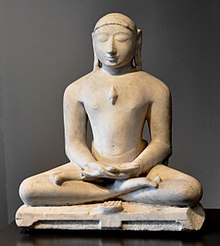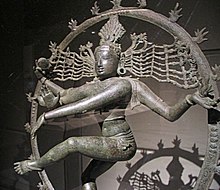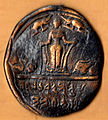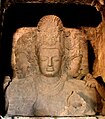Sculpture in the Indian subcontinent
| Part of a series on the |
| Culture of India |
|---|
 |
This article has multiple issues. Please help improve it or discuss these issues on the talk page. (Learn how and when to remove these template messages)
|




The first known sculpture in the Indian subcontinent is from the Indus Valley civilization. After the collapse of the Indus Valley civilization there is little record of sculpture until the Buddhist era, apart from a hoard of copper figures of (somewhat controversially) c. 1500 BCE from Daimabad.[2] Thus the great tradition of Indian monumental sculpture in stone appears to begin relatively late, with the reign of Asoka from 270 to 232 BCE, and the Pillars of Ashoka he erected around India, carrying his edicts and topped by famous sculptures of animals, mostly lions, of which six survive.[3] Large amounts of figurative sculpture, mostly in relief, survive from Early Buddhist pilgrimage stupas, above all Sanchi; these probably developed out of a tradition using wood that also embraced Hinduism.[4]
During the 2nd to 1st century BCE in far northern India, in the Greco-Buddhist art of Gandhara from what is now southern Afghanistan and northern Pakistan, sculptures became more explicit, representing episodes of the Buddha’s life and teachings.
The pink sandstone Hindu, Jain and Buddhist sculptures of Mathura from the 1st to 3rd centuries CE reflected both native Indian traditions and the Western influences received through the Greco-Buddhist art of Gandhara, and effectively established the basis for subsequent Indian religious sculpture.[4] The style was developed and diffused through most of India under the Gupta Empire (c. 320-550) which remains a "classical" period for Indian sculpture, covering the earlier Ellora Caves,[5] though the Elephanta Caves are probably slightly later.[6] Later large scale sculpture remains almost exclusively religious, and generally rather conservative, often reverting to simple frontal standing poses for deities, though the attendant spirits such as apsaras and yakshi often have sensuously curving poses. Carving is often highly detailed, with an intricate backing behind the main figure in high relief. The celebrated bronzes of the Chola dynasty (c. 850–1250) from south India, many designed to be carried in processions, include the iconic form of Shiva as Nataraja,[7] with the massive granite carvings of Mahabalipuram[8] dating from the previous Pallava dynasty.[9]
Indus Valley Civilization
The first known sculpture in the Indian subcontinent is from the Indus Valley civilization (3300–1700 BC). These include the famous small bronze dancing girl. However such figures in bronze and stone are rare and greatly outnumbered by pottery figurines and stone seals, often of animals or deities very finely depicted.[10]
-
Priest king of Mohenjo daro
-
Harappan jasper torso
-
Dancing girl bronze sculpture
-
Dancing girl statue, Mohenjo Daro
-
Daimabad Chariot
-
Woman Riding Two Bulls (bronze), from Kausambi, c.2000-1750 BCE
Pre mauryan art
Even though scholars have debated the archaeological evidence from the pre-Mauryan era, a lot of terracotta artifacts by various scholars have been dated to the pre-Mauryan era which shows continuity of the dressing styles leading up to the Mauryan period.[11] The terracotta also contain naturalistic style of depicting human faces just like Mauryan periods. The pre-Mauryan periods have been marked by the continuation of Indus arts and depict elaborate headdresses, conical hats with heavy earing. Some figurines and statues dated in pre mauryan era have naturalistic appearance and evidence of moulded figurines. Another pre-Mauryan archaeological evidence of Indian dressing comes from Saurashtra janapada coins which are one the earliest representation of Indian pre-Mauryan arts. The coins are dated between 450-300 BCE and have been repeatedly over struck just like punch-marked coins.[12]
-
Statue of ajatshatru created during Shishunaga period
-
Statue of Haryanka dynasty king Udayin
-
Statue of King Ajatshatru without a head
-
Kundpur seal allegedly from pre mauryan period from city of Vaishali from Vajjian confederacy
Mauryan period art
Mauryan period is known for its characteristic polished statues and appearance of buddhist and jain arts which appeared during the rule of Mauryan empire.
-
Ashokan pillar of a sitting lion, Vaishali
-
mauryan statue 3rd-2nd century BC
-
Lohanipur torso
-
Sarnath capital
-
statue from mauryan palace
-
Didarganj Yakshini
-
Yaksha statue
Shunga art
Terracotta arts executed during pre mauryan and mauryan periods are further refined during Shunga periods and Chandraketugarh emerges as an importance centre for the terracotta arts of Shunga period. Mathura which has its basis in pre mauryan period also emerges as an important centre for jain
-
Bharhut stupa, Shunga horseman
-
Shunga yakshi
-
Chandraketugarh figurine
-
Male figure, Chandraketugarh, India, 2nd-1st century BC
Satavahana art
Satavahana art was patronised in south India by Satavahana empire and is dated between 2nd century BC- 2nd century AD
Sanchi art
Sanchi stupas were constructed by King ashoka and later expanded by Shunga and satavahanas. Major work on decorating the site with torana gateway and railing were done by Satavahana empire.
-
Sanchi gateway
-
carved rliefs of sanchi gateway
-
Sanchi torana
-
Satavahana relief of the City of Kusinagara in the War over the Buddha's Relics, South Gate, Stupa no. 1, Sanchi
cave temples
between 2nd century BC and 2nd century AD under satavahanas several buddhist caves propped up along the coastal areas of maharashtra and these cave temples were decorated with satavahana era sculptures and hence not only some of the earliest art depictions but evidence of ancient indian architecture.
-
Kanheri caves buddha statue
-
Kanheri caves statue
Amaravathi art
Amaravati school of buddhist art was one of the three major buddhist sculpture centres along with mathura and Gandhara and flourished under Satavahanas, lots of lime stone sculptures and tablets which ones were plastered buddhist stupas provide a fascinating insight into major early buddhist school of arts.
-
Amaravati Marbles, fragments of Buddhist stupa
-
Head of a lion, from gateway pillar at the Amaravati Stupa
-
Mara's assault on the Buddha, 2nd century, Amaravati
Kushana art
Kushan art is highlighted by the appearance of extensive buddhist arts in the form of mathurs, gandharan and Amaravathi schools of art
Mathura art
Mathura art flourished in the ancient city of Mathura and predominantly red sandstone has been used in making buddhist and jain sculptures.
-
Spotted red sandstone Bodhisattwa, Mathura Art, Kusha 2nd Cent CE
-
Yakshi Mathura
-
statue of a guy, Mathura Lucknow Museum
-
Sibijataka and other Buddhist legends- Mathura School of art- 2nd century CE
-
Bhutesvara Yakshis Mathura reliefs 2nd century CE
Gandharan art
Greco-Buddhist art is the artistic manifestation of Greco-Buddhism, a cultural syncretism between the Classical Greek culture and Buddhism, which developed over a period of close to 1000 years in Central Asia, between the conquests of Alexander the Great in the 4th century BCE, and the Islamic conquests of the 7th century CE. Greco-Buddhist art is characterized by the strong idealistic realism of Hellenistic art and the first representations of the Buddha in human form, which have helped define the artistic (and particularly, sculptural) canon for Buddhist art throughout the Asian continent up to the present. Though dating is uncertain, it appears that strongly Hellenistic styles lingered in the East for several centuries after they had declined around the Mediterranean, as late as the 5th century CE. Some aspects of Greek art were adopted while others did not spread beyond the Greco-Buddhist area; in particular the standing figure, often with a relaxed pose and one leg flexed, and the flying cupids or victories, who became popular across Asia as apsaras. Greek foliage decration was also influential, with Indian versions of the Corinthian capital appearing.[13]
Although India had a long sculptural tradition and a mastery of rich iconography, the Buddha was never represented in human form before this time, but only through some of his symbols.[14] This may be because Gandharan Buddhist sculpture in modern Afghanistan displays Greek and Persian artistic influence. Artistically, the Gandharan school of sculpture is said to have contributed wavy hair, drapery covering both shoulders, shoes and sandals, acanthus leaf decorations, etc.
The origins of Greco-Buddhist art are to be found in the Hellenistic Greco-Bactrian kingdom (250 BCE – 130 BCE), located in today’s Afghanistan, from which Hellenistic culture radiated into the Indian subcontinent with the establishment of the small Indo-Greek kingdom (180 BCE-10 BCE). Under the Indo-Greeks and then the Kushans, the interaction of Greek and Buddhist culture flourished in the area of Gandhara, in today’s northern Pakistan, before spreading further into India, influencing the art of Mathura, and then the Hindu art of the Gupta empire, which was to extend to the rest of South-East Asia. The influence of Greco-Buddhist art also spread northward towards Central Asia, strongly affecting the art of the Tarim Basin and the Dunhuang Caves, and ultimately the sculpted figure in China, Korea, and Japan.[15]
-
Gandhara frieze with devotees, holding plantain leaves, in purely Hellenistic style, inside Corinthian columns, 1st–2nd century CE. Buner, Swat, Pakistan. Victoria and Albert Museum
-
970 CE Muktesvara deula, Odisha
-
Coin of Demetrius I of Bactria, who reigned circa 200–180 BC and invaded Northern India
-
Buddha head from Hadda, Afghanistan, 3rd–4th centuries
-
Gandhara Poseidon (Ancient Orient Museum)
-
Taller Buddha of Bamiyan, c. 547 AD., in 1963 and in 2008 after they were dynamited and destroyed in March 2001 by the Taliban
Middle Kingdoms (230 BCE – 1206 CE)
Temples of Khajuraho

The temples of Khajuraho, a complex of Hindu and Jain temples, were constructed in the 9th and 11th centuries CE by the Chandela clan. They are considered one of the best examples of Indian art and architecture.[16]
The temples have a rich display of intricately carved sculptures. While they are famous for their erotic sculptures, sexual themes cover less than a tenth of the temple sculpture. The sculptures depict various aspects the everyday life, mythical stories as well as symbolic display of various secular and spiritual values important in Hindu tradition.[16]
Dynasties of South India


The Chola bronzes are some of the most iconic and famous sculptures of India. They were created using the lost wax technique. The sculptures were of Shiva in various avatars with his consort Parvati, and Vishnu with his consort Lakshmi, among other deities.[17]
The most iconic among these is the bronze figure of Shiva as Nataraja, the lord of dance. In his upper right hand he holds the damaru, the drum of creation.[18] In his upper left hand he holds the agni, the flame of destruction. His lower right hand is lifted in the gesture of the abhaya mudra. His right foot stands upon the demon Apasmara, the embodiment of ignorance.[19]
Pala Empire
The Pala Empire ruled between the 8th and 12th centuries CE. During this time, the styles sculpture was influenced by those of the Gupta period.[citation needed]
Medieval and Early Modern period (1206-1858 CE)
Vijayanagara Empire
This section is empty. You can help by adding to it. (February 2019) |
Rajput Kingdoms
This section is empty. You can help by adding to it. (February 2019) |
British Colonial period (1858-1947 CE)
During this period, European styled statues were erected in city squares, as monuments to the British Empire's power. Statues of Queen Victoria, George V, and various Governor-Generals of India were erected. Such statues were removed from public places after independence, and placed within museums. However, some still stand at their original location, such as Statue of Queen Victoria, Bangalore.
Post-Independence (1947 CE - present)
Modern Indian sculptors include D.P Roy Choudhury, Ramkinkar Baij, Sankho Chaudhuri and Chintamoni Kar.[20] The National Gallery of modern Art has a large collection of modern Indian sculpture.[20]
Gallery
-
Didarganj Yakshi Sandstone Sculpture (3rd Century BCE) Mauryan Art-Patna.
-
Jain chaumukha sculpture, 1st century CE
-
'A Jain Family Group' sculpture, Los Angeles County Museum of Art, 6th century
-
Chola bronzes
-
Shiva panel, Kailash Temple (Cave 16), Ellora.
-
5 feet tall idol of the Parshwanath Akkana Basadi, 12th century
-
13th century Ganesha statue
-
Brass idol of tirthankar Parshvanatha in Walters Art Museum, 16th century
-
Stone Inscription at ASI Museum, Amaravathi
-
Secular scenes
-
Lintel Beam Model at ASI Museum, Amaravathi
-
Hindu Goddess
-
The "dancing girl of Mohenjo Daro", 3rd millennium BCE (replica)
-
Bahubali, Metropolitan Museum of Art (6th CE)
-
Buddha from Sarnath, 5–6th century CE
-
Statue of Suparshvanatha from c. 900 C.E.
-
Seated Ganesha, sandstone sculpture from Rajasthan, 9th century
-
'Jain Tirthankara', Mysore, India made of bronze with silver content, Honolulu Academy of Arts, 10th-11th century
-
The Colossal trimurti at the Elephanta Caves
-
The iconic 57 ft high monolithic Statue of Gommateshwara, Shravanabelagola, 10th Century
See also
Notes
- ^ "Sun Temple, Konârak". UNESCO World Heritage Centre. Retrieved 2012-10-12.
{{cite web}}: Cite has empty unknown parameter:|dead-url=(help) - ^ Harle, 17–20
- ^ Harle, 22–24
- ^ a b Harle, 26–38
- ^ Harle, 87; his Part 2 covers the period
- ^ Harle, 124
- ^ Harle, 301-310, 325-327
- ^ "Group of Monuments at Mahabalipuram". UNESCO World Heritage Centre. Retrieved 2019-02-20.
{{cite web}}: Cite has empty unknown parameter:|dead-url=(help) - ^ Harle, 276–284
- ^ "South Asian arts - Visual arts of India and Sri Lanka (Ceylon)". Encyclopedia Britannica. Retrieved 2019-02-20.
- ^ Gupta, C. C. Das (1951). "Unpublished Ancient Indian Terracottas Preserved in the Musée Guimet, Paris". Artibus Asiae. 14 (4): 283–305. doi:10.2307/3248779. ISSN 0004-3648.
- ^ "The COININDIA Coin Galleries: Surashtra Janapada". coinindia.com. Retrieved 2019-04-17.
- ^ Boardman, 370–378; Harle, 71–84
- ^ Dehejia, Vidya. "Buddhism and Buddhist Art". Metropolitan Museum of Art. Retrieved 2019-02-20.
{{cite web}}: Cite has empty unknown parameter:|dead-url=(help) - ^ Boardman, 370–378; Sickman, 85–90; Paine, 29–30
- ^ a b c "Khajuraho Group of Monuments". UNESCO World Heritage Centre. Archived from the original on 2019-02-14. Retrieved 2019-02-20.
{{cite web}}: Unknown parameter|dead-url=ignored (|url-status=suggested) (help) - ^ "Great Living Chola Temples". UNESCO World Heritage Centre. Archived from the original on 2018-12-26. Retrieved 2019-02-21.
{{cite web}}: Unknown parameter|dead-url=ignored (|url-status=suggested) (help) - ^ 1944-, Smith, David (David James), (2002). The dance of Siva : religion, art and poetry in South India. Cambridge: Cambridge University Press. pp. 1–2. ISBN 0521528658. OCLC 53987899.
{{cite book}}:|last=has numeric name (help)CS1 maint: extra punctuation (link) CS1 maint: multiple names: authors list (link) - ^ "Shiva as Lord of Dance (Nataraja)". Metropolitan Museum of Art. Retrieved 2019-02-20.
{{cite web}}: Cite has empty unknown parameter:|dead-url=(help) - ^ a b "Modern Sculptures". National Gallery of Modern Art, New Delhi. Retrieved 2019-02-14.
{{cite web}}: Cite has empty unknown parameter:|dead-url=(help)
References
- Boardman, John ed., The Oxford History of Classical Art, 1993, OUP, ISBN 0198143869
- Harle, J.C., The Art and Architecture of the Indian Subcontinent, 2nd edn. 1994, Yale University Press Pelican History of Art, ISBN 0300062176
- Paine, Robert Treat, in: Paine, R. T. & Soper A, The Art and Architecture of Japan, 3rd ed 1981, Yale University Press Pelican History of Art, ISBN 0140561080
- Sickman, Laurence, in: Sickman L & Soper A, The Art and Architecture of China, Pelican History of Art, 3rd ed 1971, Penguin (now Yale History of Art), LOC 70-125675
Further reading
- Lerner, Martin (1984). The flame and the lotus: Indian and Southeast Asian art from the Kronos collections. New York: The Metropolitan Museum of Art. ISBN 0870993747. Retrieved 2016-03-06.
- Welch, Stuart Cary (1985). India: art and culture, 1300-1900]. New York: The Metropolitan Museum of Art. ISBN 9780944142134.




































































